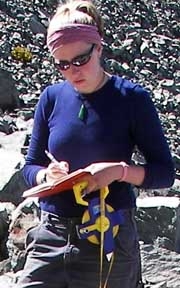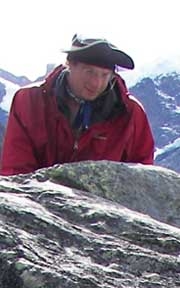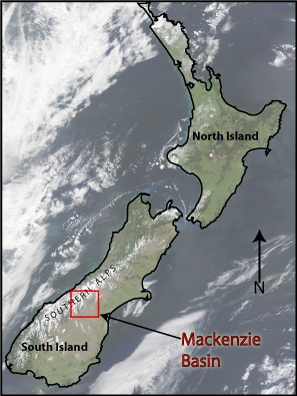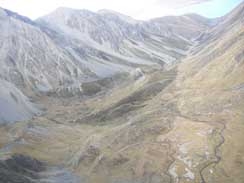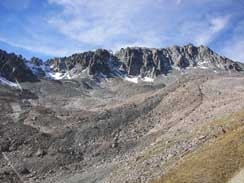Developing a chronology of glacial advances in the Southern Alps, New Zealand from the LGM to present.
Developing a chronology of glacial advances in the Southern Alps, New Zealand from the LGM to present.
Glacial Advances in the Southern Alps, New Zealand
Aaron E. Putnam, Alice M. Doughty, University of Maine
Michael R. Kaplan, Columbia University
January 19th to May 14th, 2006
A fundamental question in global climate research is whether mountain glaciers in the Southern Hemisphere advanced at the same time as Northern Hemisphere ice sheets and mountain glaciers (Denton, 1999; Kaplan et al., 2005). To address this question, we are developing a detailed chronology of the New Zealand moraine sequences deposited during, and since the last ice age. By sampling boulders on moraine crests for cosmogenic nuclide surface exposure dating we hope to resolve the age and structure of climatic events within the period of the Last Glacial Maximum (LGM; occurring ~25,000-16,000 years before present). We are particularly interested in the exact timing of the abrupt transition from the cold ice age world to the warm interglacial climate (referred to as the ‘glacial termination’) that occurred ~17,000 years ago. Additionally, using surface exposure dating, we hope to resolve the age and structure of ‘abrupt climate events’ that punctuated the Late Glacial period (14,000-10,000 years ago) and the Holocene (~10,000 years ago to present) in the Southern Hemisphere.
New Zealand is an ideal place for understanding whether or not the ice ages are caused by a global mechanism, as the island country is geographically situated on the opposite side of the globe from mid-latitude North America and Europe. The Southern Alps currently intersect the mean-annual snowline and are thus glaciated, preserving a complete record of glacial advances up to present. Recent modeling and glacier mass-balance studies suggest that modern and past glacier behavior is primarily driven by temperature changes (Mackintosh and Anderson, 2005). Thus, by combining a secure chronology for the New Zealand glacial sequence with calculated palaeosnowlines, we will have the tools necessary for reconstructing, in detail, a temperature history for the Southern Alps from the LGM to present. We hope this effort will further our understanding of the history and cause of the ice ages and abrupt climate change.
What is Surface Exposure Dating?
Due to the paucity of organic material incorporated in moraines of the semi-arid terrain east of the Main Divide of the Southern Alps, the absolute ages of these deposits have remained enigmatic. Relative weathering and lichenometry studies have been conducted to determine the age of these deposits (see Gellatly et al., 1988; Burrows et al., 1990), but large associated uncertainties render these conclusions unreliable (Porter, 2000). Recently, surface exposure age dating methods have been refined, and have gained acceptance in the geologic community. Surface exposure dating is a technique by which the age of a landform can be quantified by measuring the concentrations of cosmogenic isotopes (see Gosse and Phillips, 2001). As a glacier builds a moraine, it exposes previously buried rocks at the surface of the moraine ridge. When the ice melts away, the moraine is left with rocks poking through the surface that are henceforth exposed to galactic cosmic radiation. This cosmic ray bombardment results in ‘spallation’ reactions within the upper few centimeters of each rock, and new isotopes (termed ‘cosmogenic’) are created. In this study we focus on 10Be, an isotope created by cosmic ray interactions with quartz. Over time, the 10Be nuclides accumulate at a generally constant rate. By recovering rock samples from the tops of these rocks that have been exposed since the ice first retreated, we can measure the concentration of 10Be using Accelerator Mass Spectrometry (AMS) techniques, and calculate how long ago the rock was deposited by glacial ice. Of course, there are many geomorphic factors that may influence 10Be production rates, so each and every boulder is closely scrutinized in terms of geologic stability before we decide to take a sample.
Study Area
Our particular focus for this study is around the Mackenzie Basin, a lake district occurring east of the main divide of the Southern Alps (43°S, 170°E). Today, glaciers drain the high-elevation ice fields around Aoraki (Mount Cook) into the lower valleys. These large valleys contain deep lakes dammed by the LGM moraine system that is our principal research interest. We are in the process of sampling the moraine systems around Lakes Pukaki, Ohau, and Tekapo to constrain the chronology and structure of the LGM. Further up-valley are moraines deposited during the Late Glacial readvance, and high in the mountain cirques above the main valley are Holocene deposits ranging from ~6,000 to 60 years old. We intend to constrain the ages of these younger deposits as well, as new laboratory methods make it possible to obtain exposure ages as young as 150 years old. Our focus for the Holocene chronology will be on the Whale Stream and Irishman Stream sequences. We are conducting a similar study on the Cameron Glacier sequence located in the Arrowsmith Range northeast of Mount Cook. Understanding the timing of these sequences will afford insight into the New Zealand, Southern Hemisphere, and global climate history.



